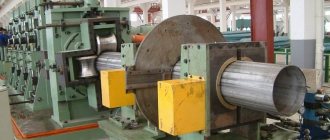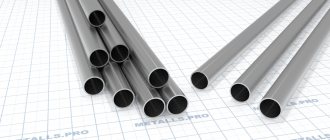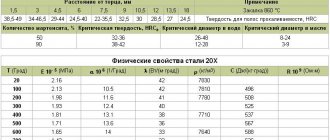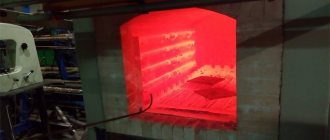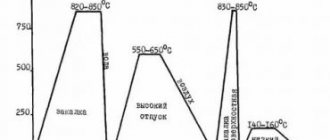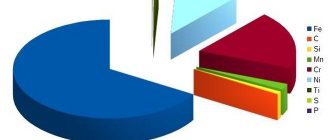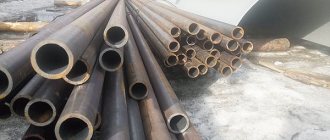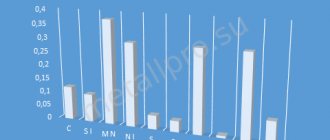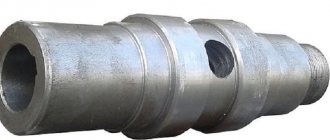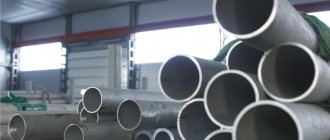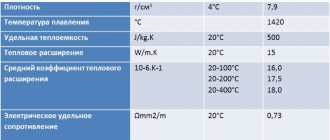Steel 13HFA
High-quality alloy structural steel.
Type of delivery : pipes made of steel 13xfa
Application: For the manufacture of pipe blanks intended for the production of seamless hot-deformed oil and gas pipeline pipes with increased corrosion resistance and cold resistance, intended for use in gas transporting systems, oil and gas pipeline systems, technological field pipelines transporting oil and petroleum products, as well as in systems for maintaining reservoir pressure in northern climatic conditions zones at ambient temperatures from -60°С to +40°С, temperatures of transported media from +5°С to +40°С and operating pressure up to 7.4 MPa. The pipes differ from conventional oil and gas pipelines in accordance with GOST 8731, GOST 8732, by increased cold resistance, increased resistance to general and pitting corrosion, resistance to sulfide corrosion cracking and the formation of hydrogen cracks.
The most common steel grades. What to choose?
The main steel grades presented on the used steel pipe market are ordinary quality carbon steel GOST 380-94, high-quality carbon steel GOST 1050-88 and high-strength low-alloy structural steel GOST 19281-89. Note: steel quality is a set of properties provided by the metallurgical process, such as the uniformity of the chemical composition, structure and properties of steel, and its manufacturability. These properties depend on the content of gases (oxygen, nitrogen, hydrogen) and harmful impurities - sulfur and phosphorus.
Steel 12Х1МФ
Low-alloy, heat-resistant structural steel. Pearlitic grade steel. Recommended application temperature up to 570-585 °C; Temperature of intensive scaling 600 °C; operating life - more than 10,000 hours.
Substitute: 12ХМФ.
Type of supply: Pipes TU 14-3р-55-2001, including long and shaped steel.
Application: For superheater pipes, pipelines and high pressure manifold installations; forgings for steam boilers and steam pipelines; gas turbine cylinder parts; for the manufacture of parts operating at temperatures of 540-580°C.
Steel 15GS
Low-alloy structural steel for welded structures.
Substitute: 12GS, 16GS.
Type of supply: Boiler pipes according to TU 14-3r-55-2001.
Application: Stationary feed water pipelines of SVP boilers operating at a temperature of 280°C. As well as truss posts, top frames of cars, center beams, I-beams and other parts of car construction, parts of excavators, elements of welded metal structures and other parts operating at temperatures from -40 to +450°C.
How Soviet steel was hardened!
Without restrictions - welding is performed without heating and without subsequent heat treatment
Limited weldability - welding is possible when heated to 100 - 120 degrees and subsequent heat treatment
Difficult to weld - to obtain high-quality welded joints, additional operations are required: heating to 200 - 300 degrees during welding, heat treatment, after welding - annealing
High strength steel grades
Steel is one of the most important materials that is used in almost all industries. Depending on the application, high-strength steel has different requirements. Steel grades differ in structure, chemical composition and in their properties (physical and mechanical).
Steel is a deformable alloy of iron with carbohydrate (no more than 2 percent) and admixtures of other elements: manganese, silicon, phosphorus. Special requirements are placed on high-strength fasteners. Therefore, to obtain steel that will ideally meet all characteristics, special impurities are added - alloying elements. These are chromium, tungsten, vanadium, titanium, manganese or silicon.
Characteristics of steel grade 20
Quality carbon structural steel
Pipes of superheaters, manifolds and pipelines of high-pressure boilers, sheets for stamped parts, cemented parts for long and very long service at temperatures from -40 to +350 degrees
Characteristics of steel grade 3
Regular quality carbon steel
This type of steel is in greatest demand in construction. The reason for this popularity is manufacturability, durability and an attractive price. Another advantage of this alloy is the ability to make products from it that can withstand heavy loads and have good impact resistance.
Steel 3 is produced according to GOST 380-94, according to which steel is marked with the letters “St” with a serial number from 0 to 6. The higher this number, the greater the amount of carbon contained in the steel. This means better strength, but worse plastic characteristics.
Steel 3 welds well, is non-flocene sensitive, and is not prone to temper brittleness. Steel 3 contains: carbon – 0.14-0.22%, silicon – 0.05-0.17%, manganese – 0.4-0.65%, nickel, copper, chromium – no more than 0.3%, arsenic no more than 0.08%, sulfur and phosphorus - up to 0.05 and 0.04%.
The amount of these components in the St3 alloy is not allowed above the specified values.
The basis of steel is ferrite. Its characteristics do not allow it to be used in its pure form. To improve the strength of ferrite, steel is saturated with carbon, chromium, nickel, silicon, manganese are added (alloyed) and additional thermal hardening is carried out.
Steel 3 withstands a wide temperature range under variable loads. It welds well, is stamped in cold and hot conditions, and is drawn. Can be used without heat treatment
Weldability of steel 3
Without restrictions - welding is performed without heating and without subsequent heat treatment. In steel classified as good, the carbon content is less than 0.25%. They are welded without the formation of hardening structures and cracks in a wide range of welding conditions.
Steel application temperature 3
The minimum temperature of use (the temperature of the coldest five-day period in the region) is minus 30.
Maximum application temperature – plus 300 degrees
Characteristics of steel grade 35
High quality medium carbon steel.
This type of steel is used for parts that require high ductility and impact resistance. High-quality carbon steels of type 35 are manufactured according to GOST 1050-88 and are marked with two-digit numbers that indicate the average carbon content in hundredths of a percent. For example, steel 35 (0.35%).
It has high strength (σв = 640...730 MPa, σ0.2 = 380...430 MPa) and relatively low ductility (δ = 9...14%, ψ = 40...50%). In addition, this type of steel is not susceptible to medium stress, is resistant to deformation and wear, and is not subject to cracking and corrosion.
Therefore, steel 35 is used in the production of high-strength fasteners and flange connections. Temperature range: -40 to +450 degrees Celsius
35 steel has limited weldability. Methods of welding RDS, ADS submerged arc and gas shield, ESW. We recommend heating and subsequent heat treatment. CTS without restrictions.
Weldability of steel 35
Structural grade 35 has limited weldability. With an increase in carbon in the steel, the heat-affected zone and the weld are hardened, hardness increases, and welded joints become more brittle and prone to cracking.
Satisfactory steels have a carbon content of 0.25 to 0.35%. They are less prone to cracking and, with the correct welding conditions, a high-quality seam is obtained. Heating is often used to improve welding quality.
Steel application temperature 35
Minimum application temperature (temperature of the coldest five-day period in the region) – minus 40 degrees
Maximum application temperature – plus 425 degrees
Characteristics of steel grade 35X
Alloy steel, chromium
Fasteners made of 35X have high structural strength and guarantee structural reliability. In addition, 35X resists impact loads well, has a large reserve of toughness and high fatigue resistance. 35X steel has high resistance to wear, corrosion, cracks and other defects.
The main advantage of fasteners made from 35X alloy structural steel over carbon ones is higher strength due to ferrite hardening and greater hardenability, less growth of austenite grains when heated, and increased impact strength. And the level of mechanical properties is increased due to heat treatment.
Steel application temperature 35x
Minimum application temperature (temperature of the coldest five-day period in the region) – minus 40 degrees
Maximum application temperature – plus 425 degrees
Characteristics of steel grade 40x
Alloy structural steel
40X steel contains 0.40% carbon and less than 1.5% chromium. This steel is quite difficult to weld. Therefore, in order to obtain a high-quality welded joint, additional operations are necessary. When welding, heating to 200-300 degrees will be required, and then heat treatment by annealing.
Thanks to the addition of chromium, steel 40X fasteners have hardness, strength, heat resistance and corrosion resistance. Steel 40X is designed for significant loads. Mechanical properties of steel 40x: short-term strength - 570 - 940 MPa, proportionality limit - 320 - 800 MPa, relative elongation - 13 - 17%, relative contraction - 35 - 55%, impact strength - 400 - 850 kJ / sq.m.
Steel 30HGSA
Structural alloy steel. Chrome-silicon-manganese steel.
Substitute : 40HFA, 35ХМ, 40ХН, 25ХГСА, 35ХГСА.
Type of delivery: seamless hot-rolled pipes
Application: Various parts to be improved: shafts, axles, gears, flanges, casings, compressor blades operating at temperatures up to 200°C, levers, pushers, critical welded structures operating under alternating loads, fasteners operating at low temperatures .
Steel grades
Weldability
| no limits | welding is performed without heating and without subsequent heat treatment |
| limited weldability | welding is possible when heated to 100-120 degrees. and subsequent heat treatment |
| difficult to weld | To obtain high-quality welded joints, additional operations are required: heating to 200-300 degrees. during welding, heat treatment after welding - annealing |
High strength steel grades
Steel is one of the most important materials that is used in almost all industries. Depending on the application, high-strength steel has different requirements. Steel grades differ in structure, chemical composition and in their properties (physical and mechanical).
Steel is a deformable alloy of iron with carbohydrate (no more than 2 percent) and admixtures of other elements: manganese, silicon, phosphorus. Special requirements are placed on high-strength fasteners. Therefore, to obtain steel that will ideally meet all characteristics, special impurities are added - alloying elements.
These are chromium, tungsten, vanadium, titanium, manganese or silicon.
Steel 20
Quality carbon structural steel
pipes for superheaters, manifolds and pipelines of high-pressure boilers, sheets for stamped parts, cemented parts for long and very long service at temperatures from -40 to 350 degrees.
STEEL GRADE 3
Regular quality carbon steel. This type of steel is in greatest demand in construction. The reason for this popularity is manufacturability, durability and an attractive price. Another advantage of this alloy is the ability to make products from it that can withstand heavy loads and have good impact resistance.
Steel 3 is produced according to GOST 380-94, according to which steel is marked with the letters “St” with a serial number from 0 to 6. The higher this number, the greater the amount of carbon contained in the steel. This means better strength, but worse plastic characteristics. Steel 3 welds well, is non-flocene sensitive, and is not prone to temper brittleness.
Steel 3 contains: carbon – 0.14-0.22%, silicon – 0.05-0.17%, manganese – 0.4-0.65%, nickel, copper, chromium – no more than 0.3%, arsenic no more than 0.08%, sulfur and phosphorus - up to 0.05 and 0.04%. The amount of these components in the St3 alloy is not allowed above the specified values. The basis of steel is ferrite. Its characteristics do not allow it to be used in its pure form.
To improve the strength of ferrite, steel is saturated with carbon, chromium, nickel, silicon, manganese are added (alloyed) and additional thermal hardening is carried out. Steel 3 withstands a wide temperature range under variable loads. It welds well, is stamped in cold and hot conditions, and is drawn. Can be used without heat treatment.
STEEL GRADE 35
High quality medium carbon steel. This type of steel is used for parts that require high ductility and impact resistance. High-quality carbon steels of type 35 are manufactured according to GOST 1050-88 and are marked with two-digit numbers that indicate the average carbon content in hundredths of a percent. For example, steel 35 (0.35%).
It has high strength (σв = 640...730 MPa, σ0.2 = 380...430 MPa) and relatively low ductility (δ = 9...14%, ψ = 40...50%). In addition, this type of steel is not susceptible to medium stress, is resistant to deformation and wear, and is not subject to cracking and corrosion. Therefore, steel 35 is used in the production of high-strength fasteners and flange connections. Temperature range: -40 to +450 degrees Celsius Steel 35 is weldable to a limited extent.
Methods of welding RDS, ADS submerged arc and gas shield, ESW. We recommend heating and subsequent heat treatment. CTS without restrictions.
STEEL GRADE 35X
Alloy steel, chromium Fasteners made of 35X have high structural strength and guarantee structural reliability. In addition, 35X resists impact loads well, has a large reserve of toughness and high fatigue resistance.
35X steel has high resistance to wear, corrosion, cracks and other defects. The main advantage of fasteners made from 35X alloy structural steel over carbon ones is higher strength due to ferrite hardening and greater hardenability, less growth of austenite grains when heated, and increased impact strength.
And the level of mechanical properties is increased due to heat treatment.
Steel grade 40x
Structural alloy steel.
40X steel contains 0.40% carbon and less than 1.5% chromium. This steel is quite difficult to weld. Therefore, in order to obtain a high-quality welded joint, additional operations are necessary. When welding, heating to 200-300 degrees will be required, and then heat treatment by annealing. Thanks to the addition of chromium, steel 40X fasteners have hardness, strength, heat resistance and corrosion resistance. Steel 40X is designed for significant loads.
Mechanical properties of steel 40x: short-term strength - 570 - 940 MPa, proportionality limit - 320 - 800 MPa, relative elongation - 13 - 17%, relative contraction - 35 - 55%, impact strength - 400 - 850 kJ / sq.m. The advantages of this steel grade: resistance to high and low temperatures and their sudden changes, can be used outdoors and even in aggressive, humid environments.
Characteristics
Reliable and high-quality seamless steel pipe ST10-20 is manufactured as a pipe option either without a welded spiral or without a longitudinal seam. Such pipes are produced by rolling on machines - pipe-rolling units. Seamless steel pipe ST10-20 is produced in pipe rolling production as cold-rolled by cold rolling after hot rolling and hot-rolled, when rolling is carried out only in hot form.
During the pipe production process, cold-deformed and hot-deformed seamless pipes ST10-20 are produced. Hot-deformed or hot-rolled pipes have an outer diameter of 25-700mm with a wall thickness of 2.5-75mm. The unmeasured length of products can be 4-12 m, and measuring pipes are also within the specified limits.
Seamless pipes ST10-20, manufactured in accordance with GOST 8732-78, are often used in shipbuilding, mechanical engineering, installation of water supply pipelines, gas and oil pipelines, and are also widely used in the construction of fuel and energy complex facilities. Manufactured from structural steel grades, such as St. 10, St. 15, St. 20, pipes differ qualitatively in such characteristics as high viscosity and low hardness of the metal. Such pipes are used only in non-critical facilities where mechanical loads and the environment of use do not place high demands on these characteristics.
Technological properties
The ease of weldability of the material allows the use of any welding method. The main indicators of the alloy, which are used to divide it into separate groups according to strength, include:
- anti-corrosion properties;
- mechanical parameters;
- weldability.
If an element made from this steel grade has a thickness of more than 36 mm, then heat treatment is performed after welding. This is due to the need to relieve residual stresses in the weld zone, which are formed during local heating during welding.
Return to content
Application
Seamless pipes ST10-20 are in high demand in various industries. Due to the homogeneous structure of the walls of the seamless ST10-20 pipe (solid drawn), these products have high strength characteristics, thanks to which the pipes are able to withstand high internal pressures.
Such performance properties make seamless steel pipes ST10-20 indispensable for pipelines through which gas, steam, etc. are supplied. In addition, seamless round pipe is widely in demand in aircraft manufacturing, mechanical engineering, boiler making and a number of other areas.
More complete information about the product can be found in the catalogue.
Source
What is the difference between steel 3 and steel 20
Weldability
| no limits | welding is performed without heating and without subsequent heat treatment |
| limited weldability | welding is possible when heated to 100-120 degrees. and subsequent heat treatment |
| difficult to weld | To obtain high-quality welded joints, additional operations are required: heating to 200-300 degrees. during welding, heat treatment after welding - annealing |
High strength steel grades
Steel is one of the most important materials that is used in almost all industries. Depending on the application, high-strength steel has different requirements. Steel grades differ in structure, chemical composition and in their properties (physical and mechanical).
Steel is a deformable alloy of iron with carbohydrate (no more than 2 percent) and admixtures of other elements: manganese, silicon, phosphorus. Special requirements are placed on high-strength fasteners. Therefore, to obtain steel that will ideally meet all characteristics, special impurities are added - alloying elements.
These are chromium, tungsten, vanadium, titanium, manganese or silicon.
